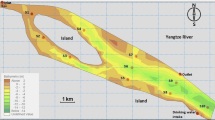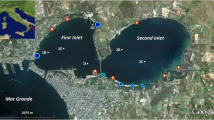Abstract
Phytoplankton and water quality of Marathonas drinking-water Reservoir were examined for the first time. During the study period (July–September 2007), phytoplankton composition was indicative of eutrophic conditions although phytoplankton biovolume was low (max. 2.7 mm3 l − 1). Phytoplankton was dominated by cyanobacteria and diatoms, whereas desmids and dinoflagellates contributed with lower biovolume values. Changing flushing rate in the reservoir (up to 0.7% of reservoir’s water volume per day) driven by water withdrawal and occurring in pulses for a period of 15–25 days was associated with phytoplankton dynamics. Under flushing pulses: (1) biovolume was low and (2) both ‘good’ quality species and the tolerant to flushing ‘nuisance’ cyanobacterium Microcystis aeruginosa dominated. According to the Water Framework Directive, the metrics of phytoplankton biovolume and cyanobacterial percentage (%) contribution indicated a moderate ecological water quality. In addition, the total biovolume of cyanobacteria as well as the dominance of the known toxin-producing M. aeruginosa in the reservoir’s phytoplankton indicated a potential hazard for human health according to the World Health Organization.
Similar content being viewed by others
References
Barbosa, F. A. R., and Padisák, J. (2002). The forgotten lake stratification pattern: atelomixis, and its ecological importance. Verhandlungen internationale Vereinigung für theoretische und angewandte Limnologie, 28, 1385–1395.
Bartram, J., Burch, M., Falconer, I. R., Jones, G., & Kuiper-Goodman, T. (1999). Situation assessment, planning and management. In I. Chorus, & J. Bartram (Eds.), Toxic cyanobacteria in water (pp. 179–209). London: E and FN Spon.
Chrisostomou, A., Moustaka-Gouni, M., Sgardelis, S., & Lanaras, T. (2009). Air-dispersed phytoplankton in a Mediterranean River-Reservoir System (Aliakmon-Polyphytos, Greece). Journal of Plankton Research, 31, 877–884.
Clarke, K. R., & Warwick, R. M. (1994). Change in marine communities: An approach to statistical analysis and interpretation. Plymouth: Natural Environment Research Council, Plymouth Marine Laboratory.
Cook, C. M., Moustaka-Gouni, M., Gkelis, S., & Lanaras, T. (2005). Greece: Cyanotoxin risk assessment, risk management and regulation. In I. Chorus (Ed.), Current approaches to cyanotoxin risk assessment, risk management and regulations in different countries (pp. 69–75). Berlin: Federal Environmental Agency (Umweltbundesamt).
Cook, C. M., Vardaka, E., & Lanaras, T. (2004). Toxic cyanobacteria in Greek Freshwaters, 1987–2000: Occurrence, toxicity, and impacts in the Mediterranean region. Acta Hydrochimica et Hydrobiologica, 32, 107–124.
European Parliament Council (2000). Directive 2000/ 60/EC of the European Parliament and of the council of 23 October 2000 establishing a framework for community action in the field of water policy. Official Journal of the European Communities, L327, 1–72.
Gaedeke, A., & Sommer, U. (1986). The influence of the frequency of periodic disturbances on the maintenance of phytoplankton diversity. Oecologia, 71, 25–28.
Gkelis, S., Harjunpää, V., Lanaras, T., & Sivonen, K. (2005a). Diversity of hepatotoxic microcystins and bioactive anabaenopeptins in cyanobacterial blooms from Greek freshwaters. Environmental Toxicology, 20, 249–256.
Gkelis, S., Moustaka-Gouni, M., Sivonen, K., & Lanaras, T. (2005b). First report of the cyanobacterium Aphanizomenon ovalisporum Forti in two Greek lakes and cyanotoxin occurrence. Journal of Plankton Research, 27, 1–6.
Hajnal, É., & Padisák, J. (2008). Analysis of long-term ecological status of Lake Balaton based on the ALMOBAL phytoplankton database. Hydrobiologia, 599, 227–237.
Hillebrand, H., Dürselen, C. D., Kirschtel, D., Pollingher, U., & Zohary, T. (1999). Biovolume calculation for pelagic and benthic microalge. Journal of Phycology, 35, 403–424.
Huisman, J., Sharples, J., Stroom, J. M., Visser, P. M., Edwin, W., Kardinaal, A., et al. (2004). Changes in turbulent mixing shift competition for light between phytoplankton species. Ecology, 85(11), 2960–2970.
JRC European Commission (2009). Water Framework Directive Intercalibration technical report. Part 2: Lakes. Joint Research Centre, European Commission. http://circa.europa.eu/Public/irc/jrc/jrc_eewai/library?l=/intercalibration_2/jrc51340-volumelakespdf/_EN_1.0_and a=d. Accessed 28 June 2010.
Kennedy, R. H. (1999). Reservoir Design and Operation: Limnological implications and management opportunities. In J. G. Tundisi, & M. Straškraba (Eds.), Theoretical reservoir ecology and its applications (pp. 1–28). The Netherlands: Backhuys.
Kurmayer, R., Christiansen, G., & Chorus, I. (2003). The abundance of microcystin-producing genotypes correlates positively with colony size in Microcystis sp. and determines its microcystin net production in lake Wannsee. Applied Environmental Microbiology, 69, 787–795.
Lymperopoulou, D. S., Kormas, K. A., Moustaka-Gouni, M., & Karagouni, A. D. (2010). Diversity of cyanobacterial phylotypes in a Mediterranean drinking water reservoir (Marathonas, Greece). Environmental Monitoring Assessment. doi:10.1007/s10661-010-1378-7.
Moustaka, M. (1988). Seasonal variations, annual periodicity and spatial distribution of phytoplankton in Lake Volvi. Doctoral dissertation. Aristotle University of Thessaloniki, Greece.
Moustaka-Gouni, M. (1993). Phytoplankton succession and diversity in a warm monomictic, relatively shallow lake: Lake Volvi, Macedonia, Greece. Hydrobiologia, 249, 33–42.
Moustaka-Gouni, M., Albanakis, K., Mitrakas, M., & Psilovikos, A. (2000). Planktic autotrophs and environmental conditions in the newly-formed hydroelectric Thesaurus reservoir, Greece. Archiv für Hydrobiologie, 149, 507–526.
Moustaka-Gouni, M., & Nikolaidis, G. (1992). Phytoplankton and physical–chemical features of Tavropos Reservoir, Greece. Hydrobiologia, 228, 141–149.
Moustaka-Gouni, M., Vardaka, E., Michaloudi, E., Kormas, K. A., Tryfon, E., Mihalatou, H., et al. (2006). Plankton food web structure in a eutrophic polymictic lake with a history of toxic cyanobacterial blooms. Limnology and Oceanography, 51, 715–727.
Moustaka-Gouni, M., Vardaka, E., & Tryfon, E. (2007). Phytoplankton species succession in a shallow Mediterranean lake (L. Kastoria, Greece): Steady-state dominance of Limnothrix redekei, Microcystis aeruginosa and Cylindrospermopsis raciborskii. Hydrobiologia, 575, 129–140.
Naselli-Flores, L. (1999). Limnological aspects of Sicilian reservoirs: A comparative, ecosystem approach. In J. G. Tundisi, & M. Straškraba (Eds.), Theoretical reservoir ecology and its applications (pp. 283–311). The Netherlands: Backhuys.
Naselli-Flores, L. (2000). Phytoplankton assemblages in twenty-one Sicilian reservoirs: relationships between species composition and environmental factors. Hydrobiologia, 424, 1–11.
Naselli-Flores, L., & Barone, R. (2005). Water-level fluctuations in Mediterranean reservoirs: setting a dewatering threshold as a management tool to improve water quality. Hydrobiologia, 548, 85–99.
Padisák, J., Borics, G., Grigorszky, I., & Soróczki-Pintér, É. (2006). Use of phytoplankton assemblages for monitoring ecological status of lakes within the Water Framework Directive: The assemblage index. Hydrobiologia, 553, 1–14.
Padisák, J., Crossetti, L. O., & Naselli-Flores, L. (2009). Use and misuse in the application of the phytoplankton functional classification: a critical review with updates. Hydrobiologia, 621, 1–19.
Padisák, J., Köhler, J., & Hoeg, S. (1999). The effect of changing flushing rates on development of late summer Aphanizomenon and Microcystis populations in a shallow lake, Müggelsee, Berlin, Germany. In J. G. Tundisi, & M. Straškraba (Eds.), Theoretical reservoir ecology and its applications (pp. 411–424). The Netherlands: Backhuys.
Padisák, J., & Reynolds, C. S. (1998). Selection of phytoplankton associations in Lake Balaton, Hungary, in response to eutrophication and restoration measures, with special reference to the cyanoprokaryotes. Hydrobiologia, 384, 41–53.
Reynolds, C. S. (2006). Ecology of phytoplankton. Cambridge: Cambridge University Press.
Reynolds, C. S., Huszar, V., Kruk, C., Naselli-Flores, L., & Melo, S. (2002). Towards a functional classification of the freshwater phytoplankton. Journal of Plankton Research, 24, 417–428.
Reynolds, C. S., & Jaworski, G. H. M. (1978). Enumeration of natural Microcystis populations. European Journal of Phycology, 13, 269–277.
Reynolds, C. S., Padisák, J., & Sommer, U. (1993). Intermediate disturbance in the ecology of phytoplankton and the maintenance of species diversity: A synthesis. Hydrobiologia, 249, 183–188.
Schembri, M. A., Neilan, B. A., & Saint, C. P. (2001). Identification of genes implicated in toxin production in the cyanobacterium Cylindrospermopsis raciborskii. Environmental Toxicology, 16, 413–421.
Sivonen, K., & Jones, G. (1999). Cyanobacterial toxins. In I. Chorus, & J. Bartram (Eds.), Toxic cyanobacteria in water (pp. 41–110). London: E and FN Spon.
Souza, M. B. G., Barros, G. F. A., Barbosa, F., Hajnal, É., & Padisák, J. (2008). Role of atelomixis in replacement of phytoplankton assemblages in Dom Helvécio Lake, South-East Brazil. Hydrobiologia, 607, 211–224.
Straškraba, M., & Tundisi, J. G. (1999). Reservoir ecosystem functioning: Theory and application. In J. G. Tundisi, & M. Straškraba (Eds.), Theoretical reservoir ecology and its applications (pp. 565–583). The Netherlands: Backhuys.
Tundisi, J. G., Matsumura-Tundisi, T., & Rocha, O. (1999). Theoretical basis for reservoir management. In J. G. Tundisi, & M. Straškraba (Eds.), Theoretical reservoir ecology and its applications (pp. 505–528). The Netherlands: Backhuys.
Utermöhl, H. (1958). Zur Vervollkommnung der quantitativen Phytoplanktonmethodik. Mitteilungen Internationale Vereinigung Theorie Angewandte Limnologie, 9, 1–38.
Vardaka, E., Moustaka-Gouni, M., Cook, C. M., & Lanaras, T. (2005). Cyanobacterial blooms and water quality in Greek waterbodies. Journal of Applied Phycology, 17, 391–401.
Author information
Authors and Affiliations
Corresponding author
Rights and permissions
About this article
Cite this article
Katsiapi, M., Moustaka-Gouni, M., Michaloudi, E. et al. Phytoplankton and water quality in a Mediterranean drinking-water reservoir (Marathonas Reservoir, Greece). Environ Monit Assess 181, 563–575 (2011). https://doi.org/10.1007/s10661-010-1851-3
Received:
Accepted:
Published:
Issue Date:
DOI: https://doi.org/10.1007/s10661-010-1851-3




